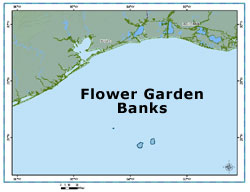|
 Tennessee Aquarium Brings Sanctuary to Heartland Tennessee Aquarium Brings Sanctuary to Heartland
A view of the Flower Garden Banks National Marine Sanctuary is recreated in a 600,000-gallon exhibit in a new wing of the Tennessee Aquarium that opened in April 2005. The replica represents a realistic look at the sanctuary’s coral reef cap and its inhabitants like sand tiger sharks and numerous colorful reef fish. Video and multimedia stations are also available for people to learn more about the sanctuary. The aquarium receives an average of one million visitors each year and reflects the sanctuary program’s efforts to partner with aquaria around the country to enhance public awareness of national marine sanctuaries.
Coral Cores May Hold Key to Protecting Reefs
Scientists are using cores obtained from large living coral heads to determine the age of the coral reef and to conduct research on historical weather patterns over the last several hundred years. The longest of the cores, collected could potentially yield an exciting 400-500 years of data. As coral colonies grow, new layers of skeleton are deposited. By analyzing differences in the characteristics of each layer and correlating that with known environmental conditions in the region at those times, scientists can evaluate cores that go back farther than recorded weather data, allowing them to “read” weather history.
Understanding how climate change has affected the Gulf of Mexico over a period of decades or centuries may help us recognize and anticipate future changes in climate so that we can adaptively manage our marine resources.
New Species Discovered in Sanctuary
Scientists were pleased to formally announce that they have identified six algae species that are new to science and 25 species of crustaceans previously unknown in the sanctuary. The recent discoveries are all described in the summer issue of Gulf of Mexico Science, an issue dedicated to recent scientific discoveries and research in and around the sanctuary.
There is also a review of recent high-resolution bathymetry data of a number of reefs and banks in the vicinity of the sanctuary. This new information is important in planning future management options and identifying locations for additional studies.
Exploration Yields Habitat Characterization Maps
Managers must understand how sanctuary habitats fit into the larger mosaic of the Gulf of Mexico to successfully manage impacts to the sanctuary. To begin developing this understanding, mapping and exploration efforts were extended to a number of other reefs and banks in the vicinity of the sanctuary. These explorations have revealed that the Flower Garden Banks may be connected to other regional banks through low relief ridges that form “habitat highways,” providing protection and foraging grounds for animals traveling between the various banks. Click here for full story and graphics.
Exclusive Stories for the Web
Monitoring Tracks Changes in Coral Reef
The Flower Garden Banks Long-Term Monitoring Program was initiated in 1988, before the banks became a national marine sanctuary. It is one of the longest running reef-monitoring programs in the Gulf of Mexico. Field data is collected once a year to assess the status and health of the coral reef cap, including parameters such as percent coral cover, coral growth, disease occurrence and bleaching. In 2005, the monitoring effort resulted in the first recorded sighting of Acropora palmata, a type of elkhorn coral, on the East Flower Garden Bank. The only other specimen observed in the sanctuary was sighted several years ago on the West Flower Garden Bank. Similar monitoring protocols were initiated at Stetson Bank.
Long-term monitoring data is supplemented by scientists conducting research in the sanctuary. Unusual observations on the reef are also reported by recreational divers and many are further investigated by sanctuary staff and partners. In January 2005, scientists documented an outbreak of coral disease. Although not severe compared to similar outbreaks on Caribbean reefs, it was more widespread than has been seen previously at the Flower Garden Banks. It was also unusual in that it peaked during the colder winter months, rather than in the warmer summer months. Coral tissue samples were collected for analysis. While the disease has not yet been definitively identified, it appears to be a condition known as “white plague.” Continued observation indicates that the disease is either dormant for now, or that it is no longer spreading. Sanctuary staff continue to monitor the situation.
Through supplemental monitoring, scientists also observed and documented an unprecedented bleaching event at the Flower Garden Banks. It was first observed in late summer and by early fall had increased such that up to 40 percent of the coral colonies were affected to some degree. Additionally, scientists noted moderate damage resulting from the passage of Hurricane Rita. Large coral colonies were ripped from their positions and toppled over. Large quantities of sand were swept from the flats and deposited elsewhere on the reef, often into the large barrel sponges. The long-term monitoring program and supplemental monitoring efforts are the primary tool that resource managers will use to assess how well the reefs are recovering from all of these events.
 Plans for 2006 Plans for 2006
The site will begin revising its management plan. This effort will involve working with key stakeholders and the public to reexamine the blueprint to how the sanctuary’s science, education and resource protection programs are held. Many public scoping meetings and information workshops will be held in 2006 and beyond. These will offer the public an opportunity to provide input on current and emerging issues as well as their views on how the sanctuary can most effectively meet its mandates. Information about the review process and how to get involved will be available on the Web site.
|



